We also are seeing increased collaborative efforts between DAACs and across missions. In order to help facilitate the on-boarding of new users of data in the cloud, a vast organization of folks at the DAACs are developing a number of cloud primers. It’s everything from how to cloud to being able to do meaningful work in the cloud.
As EOSDIS data evolve to the commercial cloud, how will this change how the DAACs archive and distribute EOSDIS data?
This will necessitate changes in the underlying technology and processes that the DAACs currently employ, including developing and deploying systems that are within a common secure cloud platform framework. This includes all of the ingest, archive, and distribution functions that the DAACs use, including storage, backup, and the operational monitoring of tools and services. It will also include developing and deploying new mission archives using a common framework for data ingest, archive, and distribution, back-up, metrics collection, metadata curation, and cataloging functions.
Additionally, they’ll need to develop and employ common frameworks for data services tools, change services, and operations like performing data transformations, subsetting, mosaicking, reformatting, and regridding. This will include not just common services, but also what we used to call DAAC Unique Extensions, which is getting to the tools and services that will plug into those frameworks and serve the unique needs of DAAC users.
Will the role of the DAACs change with this cloud evolution?
Fundamentally, the role of the DAACs won’t change. DAACs will remain the stewards of our data products and of the products in their catalogs. They will continue to ensure that NASA Earth science data remain free, open, and accessible to all who need and want these data.
Now, the location of the archive and the data may change, but the development activities, the engineering, the operations support, and user support activities will remain. The DAACs will continue to be responsible for archiving and distributing the data they always have been responsible for. They will continue to develop and provide the tools and applications for using the data they distribute. They certainly will continue to provide user services and support their data user communities in the ways their community has come to expect. The DAACs will always serve as centers for discipline-specific expertise.
Some of the user support services that the DAACs provide will necessarily need to change. Our objective is to smooth the transition to use of the cloud by our communities of data users and help them determine how cloud capabilities can best be brought to bear in solving their specific needs.
A lot of this initially entails working with our data users to change their mindsets a little bit about how they use and interact with data. We’ll have to assist their transition to the cloud by providing scenarios and information about how they can perform significant processing, data reduction, and analysis close to the data that are in the cloud.
Looking ahead, what does the future hold for EOSDIS data users and their interactions with the DAACs?
As more NASA data evolve to the cloud, the biggest immediate changes that we’ll see are in the types of support that users will be expecting and requesting from the DAACs.
When we take a look at what future cloud-resident data lakes look like, and we have multi-platform, multi-instrument, multi-discipline data in them, this presents opportunities that did not exist previously and will allow for newer, faster, more powerful ways to work with these data and new opportunities for science.
The DAACs will be providing expert user support in their respective disciplines and facilitating support in other DAAC disciplines where it’s necessary. They’ll be serving as facilitators to help users bring their analysis and processing into the cloud and take advantage of all the benefits that the cloud provides. Naturally, the DAACs will be sharing and leveraging the growing body of knowledge and lessons-learned from all of our preparatory work across EOSDIS organizations.
What are you most excited about over the next five years in terms of EOSDIS data and how data users will interact with these data?
Early in my career I worked with people who had very big ideas about what they wanted to do with remotely-sensed data. Technology was always a limiting factor, whether this was processing power or storage capabilities or network bandwidth.
In our transition to the cloud, this concept has been totally reversed. The limiting factor now is only people’s imagination. What can they do with all of this power and these vast data resources in the cloud? There are certainly things our users want to do at large-scale, but there are plenty of investigations that have not even been thought of. I’m really excited to see where this goes.


